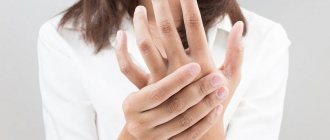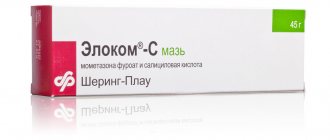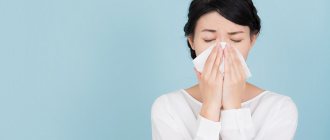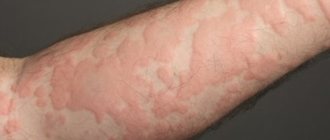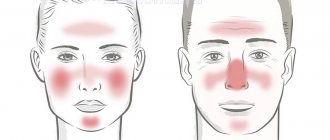Last update: 02/21/2021
Allergic reactions often cause various skin manifestations - rash, redness, irritation or swelling. Allergic dermatitis can often be difficult to distinguish from other skin conditions, such as infections or hives. Allergies are especially often confused with prickly heat, which occurs due to poor hygiene or temperature conditions.
What is the difference between prickly heat and allergies and how to determine which disease a child or an adult is suffering from? In order to answer this question, it is necessary to know the causes and symptoms of each disease and the characteristics of their course. In addition, the photos of heat rash and allergies presented on this page will help you.
Causes and symptoms of allergies
Many different factors can cause an allergic reaction - food, household chemicals, animal hair and pollen, fabrics, medications and even ultraviolet radiation. Sometimes even this knowledge is enough to distinguish allergies from prickly heat. If you've recently made changes to your usual diet, started taking new medications, or changed brands of laundry detergent, these factors are likely to be the cause of your breakouts. However, allergies can also arise unexpectedly - for example, if you have never previously noticed a negative reaction of the body to dog hair, and have only recently encountered this problem. In this case, special tests can help - they will not only help establish the presence of an atypical reaction to certain irritants, but will also help identify a specific allergen.
Usually, to get rid of the symptoms of prickly heat, it is enough to eliminate the factors that cause waterlogging and contamination of the skin - most often this is a lack of hygiene, poor ventilation of the skin due to clothing, or staying in hot and poorly ventilated rooms. In most cases, symptoms quickly disappear after this. An allergic rash is much more persistent: it is difficult to treat and does not always go away even after eliminating contact with the allergen.
Why does sweat rash occur?
Miliaria occurs due to blockage of the ducts of the sweat glands, which is facilitated by the structural features of the skin of young children and external conditions: if the child overheats and, accordingly, sweats a lot. Thus, a rash may appear if a child spends a long time in a hot room with high humidity, is wrapped up too warmly when walking, is dressed in tight clothes made of synthetic fabrics, or is wearing diapers in the heat. Sweat is not removed outside, remains in the skin and causes redness and rashes.
It is important!
Heat rash can be caused by frequent or excessive use of baby creams, especially fatty ones, and baby cosmetic oils.
Heat rash often occurs in children with a thick build and pronounced folds on the arms and legs.
As for the characteristics of the skin of newborns, it is still thin, and the excretory ducts of the sweat and sebaceous glands continue to form, so it cannot fully perform protective functions and quickly loses moisture. All this leads to the fact that the ducts of the sweat glands are easily clogged. In addition, babies cannot say that they are hot or take off uncomfortable tight clothes, and mothers tend to dress them warmer to be on the safe side.
Causes and symptoms of prickly heat
Heat rash usually occurs when your skin becomes overheated and too wet, for example if you wear clothes that are too tight or are in a particularly hot and humid climate. Heat rash in newborns and infants often occurs when swaddling is too tight or low-quality diapers are used. This leads to one of the main differences between prickly heat and allergies - the limited localization of the rash. Typically, the symptoms of this disease appear locally - where clothing hides the skin, on the elbows or knees, in the area of skin or fat folds, under the hair. Allergy can affect both small areas of the skin and the entire surface of the body, since it is a systemic reaction of the body. In addition, the development of heat rash is often preceded by skin irritation - for example, friction from a tight collar or scarf.
The symptoms of the two diseases are very similar: the appearance of a small papular and/or vesicular rash. Most often, the affected skin turns red and swollen, becomes sensitive and irritated.
Features of the manifestation of allergic rashes in children
Unlike prickly heat, allergies in children do not have a clear localization and can appear on any part of the body. Most often it affects the baby's face, arms, legs, tummy and back. The rash looks like small blisters filled with fluid and prone to peeling. The rashes coalesce into large lesions that cause itching.
You can distinguish sweat rash from allergies in a newborn by the absence of large draining lesions that look like inflamed spots. The elements of the rash caused by prickly heat are small and do not merge with each other. Also, with allergies, additional symptoms may appear: runny nose, dry cough, nasal congestion, headache, refusal to eat.
Allergic rashes can appear for the following reasons:
- Changing the child's diet - introducing complementary foods or switching from breastfeeding to formula. Most often, this situation arises when using baby products that are not age-appropriate to feed a baby;
- Change in the mother’s diet - while the baby is feeding on milk, everything that the woman has eaten goes into the baby’s body. Even the most harmless product can cause a rash on the skin;
- Changing the type of baby soap, diapers, talcum powder, napkins. Modern children have reactions even to hypoallergenic skincare products;
- Taking medications by mother and child. Often this situation occurs during self-medication. Taking antibiotics is especially dangerous because they cause dysbacteriosis, causing allergization of the body.
If an allergic rash appears, be sure to consult a doctor. After all, first you need to find out what exactly the baby reacted to. Taking antihistamines is possible only as prescribed by a specialist.
Treatment of diseases
Each of these diseases requires its own approach to treatment, but the basis of therapy is the elimination of factors that cause skin irritation. In the case of allergies, anti-inflammatory drugs (local, including hormonal) can be an effective remedy, as well as desensitization - a gradual decrease in sensitivity to the allergen. Miliaria usually does not require special treatment, unless it is caused by systemic disorders in the endocrine, nervous or cardiovascular systems.
In order to get rid of the most unpleasant symptoms of the disease, you should use special cosmetics, in particular La-Cri products. They do not contain substances that can cause an allergic reaction, and the main active ingredients in them are extracts of medicinal plants. La-Cri products are excellent for caring for irritated and painful skin in both adults and children.
MUTRINA - WHAT TO TREAT
— Alla Anatolyevna, how do you feel about home self-treatment of prickly heat?
— In case of any rashes, changes in skin condition, blisters or redness, it is better to visit a doctor. If it is not possible to quickly get an appointment, you can try to help the child yourself. But the lack of improvement is always a reason to consult a pediatrician (and for adults, a dermatologist).
— How to get rid of heat rash in a newborn?
— Miliaria is not a very dangerous disease and does not affect health. But the condition is unpleasant - unsightly red spots, itching, dryness, burning. If prickly heat is noticed in time, there are no purulent complications from the skin fatty tissue, treatment is started early, everything goes away within 7-10 days.
Clinical researches
Clinical studies have proven the effectiveness, safety and tolerability of the products. The products are suitable for daily care of children's skin with mild to moderate forms of atopic dermatitis and during remission, accompanied by a decrease in the quality of life of patients.
Sources:
- Sukolin Gennady Ivanovich, Clinical dermatology. A short guide to the diagnosis and treatment of dermatoses, publishing house: Notabene, 2017
- Pankratov Valentin Gavrilovich, Pankratov Oleg Valentinovich, Infectious dermatology in the practice of primary care physicians, New Knowledge Publishing House, 2015
- Mancini A. J., Krouchuk D. P., Pediatric dermatology. Publisher: Practical Medicine, Directory, 2018
- Kildiyarova Rita Rafgatovna, Pediatrician for every day. Guide for doctors, publishing house GEOTAR-Media, 2021
Photos of heat rash
Photo album on the diseaseCauses
- overheating of the skin;
- overheating of the body;
- skin contamination;
- using creams that are too rich;
- infectious disease and high fever.
Advice:
Air baths can be arranged for a baby when the air temperature is warmed up to +23...+24°C, no less. Make sure there are no drafts and that the baby's skin is not exposed to direct sunlight.
This is what we will do to eliminate the causes.
Prevention of prickly heat
- In the summer heat, bathe your baby 2-3 times a day. Splashing in the bath for 10-15 minutes is so great! Evening bathing, naturally, remains a ritual for putting the baby to bed. Use wet wipes often.
- Don't wrap your baby up. In the hottest weather, the child can be kept completely naked (indoors). Give air baths more often and leave the baby without a diaper.
- To treat your baby's skin in the summer heat, use light lotions and oils. Avoid greasy creams that create a film on the skin that contributes to the appearance of prickly heat.
- If your baby catches a cold in the summer and has a high fever, wipe him with a damp cloth to remove excess sweat from the skin and protect it from irritation.
- Make sure that the air temperature in the room where the baby is located does not exceed +23...+24°C.
- Dress your child only in clothes made of breathable materials - cotton, linen, bamboo, which allow the skin to get rid of excess heat and do not retain sweat.
As you can see, preventing the appearance of heat rash is not so difficult and every mother can do it. But if prickly heat does appear, don’t panic: it’s also easy to eliminate. But more on that next time.
Traditional methods of treatment
In the initial stages of the pathology, when prickly heat is localized in the diaper area and in the folds of the skin, it can be treated with traditional methods. These are herbal decoctions that are added to baths, used as rubdowns or lotions.
Before using a new plant, you must first rub its decoction on a small area of skin on the inside of the baby’s forearm to check for tolerance.
For newborns, herbs should be used with caution; they often cause an allergic reaction. There are only a few plants that are allowed at this age.
- Chamomile and string are used most often. You can brew them together or separately. They relieve inflammation, soothe itching and irritation, and disinfect. You can brew them in the proportion of 120 g of herb per half liter of boiling water. The cooled and strained broth is poured into the bath.
- Yarrow has an anti-inflammatory effect, normalizes the functioning of the sebaceous glands and is considered a natural antibiotic. Therefore, its use is effective for prickly heat. You need to make a decoction of 20 g of dry grass and a glass of boiling water. After cooling, strain and add to the bath water.
- Oak bark cleanses, dries wounds, and disinfects. The decoction relieves inflammation and normalizes the functioning of the sweat glands. 20 g of bark per 500 ml of boiling water is enough. After brewing, you need to boil it for 5 minutes so that more tannins are transferred into the water.
- A decoction of bay leaves is used for baths and rubbing the skin. It heals wounds, stimulates regeneration processes, and disinfects. You need to pour 7 leaves with a glass of water, bring to a boil and boil for 5 minutes. Wash the areas affected by prickly heat with the decoction using cotton pads.
You can wipe the baby's skin with a soda solution. Dissolve a teaspoon of soda in a glass of warm boiled water. Soak a cotton pad in the solution and wipe the affected areas without pressing on the skin.


